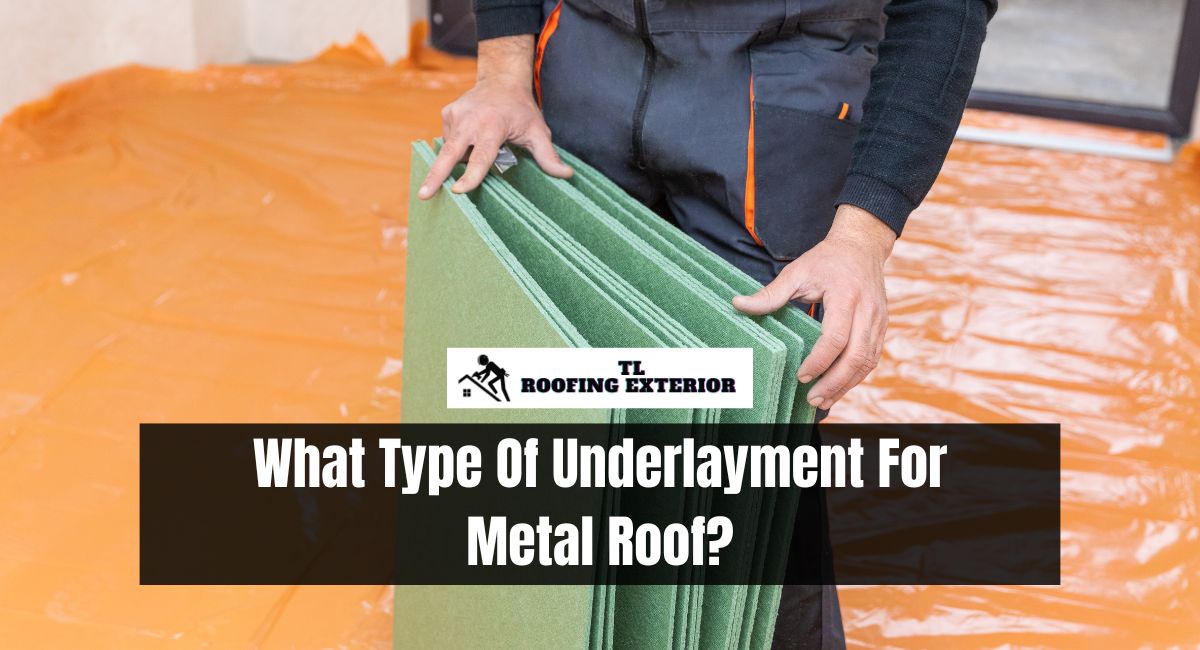Although metal roofing is lauded for its resilience and energy efficiency, the underlayment beneath it plays a crucial role in augmenting its performance and longevity. The proper underlayment, which serves as a barrier against moisture, wind, and temperature fluctuations, can make all the difference in the overall quality of your roofing system.
But with options varying from traditional felt to modern synthetic materials, how do you choose the best underlayment for your metal roof?
This article will examine the numerous types of underlayment, their pros and cons, and the factors to consider when making a selection.
What Type Of Underlayment For Metal Roof?
The type of underlayment you choose for a metal roof can have a significant impact on the roof’s performance and longevity. Here are some common types of underlayment used under metal roofing, along with their pros and cons:
1. Felt Underlayment (Asphalt-Saturated)
Pros:
- Accessibility: This type of underlayment is widely available and can be found at most home improvement stores.
- Familiarity: Roofing contractors are generally very familiar with this material, making it a straightforward option for installation.
Cons:
- Shorter Lifespan: Felt underlayment tends to degrade faster than synthetic or rubberized options, making it less ideal for long-term applications.
- Vulnerability to Wind: It can tear more easily in high winds during installation.
Best For: This is often used for budget-conscious projects or for roofing that will be covered quickly. It’s not generally recommended for metal roofs that are meant to last a long time without maintenance.
2. Synthetic Underlayment
Pros:
- UV Resistance: Many synthetic underlayments are resistant to UV degradation, allowing for a longer exposure time before the metal roofing is installed.
- Slip-Resistant: Some synthetic options come with a slip-resistant surface for safer installation.
Cons:
- Compatibility: Not all synthetic underlayments are compatible with all types of metal roofing, so it’s crucial to check manufacturer guidelines.
Best For: Those looking for a durable, water-resistant option that can withstand various weather conditions. It’s often used in both residential and commercial metal roofing projects.
3. Rubberized Asphalt Underlayment
Pros:
- Sealing Capability: The adhesive nature of rubberized asphalt provides excellent sealing around roof penetrations like vents, chimneys, and skylights.
- Sound Dampening: This type of underlayment can also provide some level of soundproofing.
Cons:
- Temperature Sensitivity: In colder climates, the adhesive may not stick as well, requiring additional fasteners or adhesives.
- Chemical Compatibility: Some types of metal may not be compatible with rubberized asphalt, leading to corrosion.
Best For: Areas prone to heavy rain or snow, or where additional sealing around roof penetrations is desired.
4. Self-Adhering Membrane (Ice and Water Shield)
Pros:
- Versatility: Often used in problematic areas like valleys, eaves, and around roof penetrations to provide extra protection.
- Ease of Installation: The self-adhering nature of this material makes it relatively easy to install, although professional installation is usually recommended for best results.
Cons:
- Cost Factor: Given its high cost, it’s generally used selectively rather than across the entire roof.
- Temperature Limitations: May require special adhesives or installation techniques in very hot or cold climates.
Best For: This is ideal for use in high-risk areas prone to ice dams or water pooling. It’s often used in conjunction with another type of underlayment for the rest of the roof.
Considerations
- Climate: The local climate can influence the best choice of underlayment. For example, rubberized asphalt may be better in wet climates, while synthetic underlayments often perform well in a wide range of conditions.
- Roof Slope: Steeper roofs may have different underlayment requirements than low-slope or flat roofs.
- Local Building Codes: Always check local building codes to ensure that your choice of underlayment meets all local regulations and standards.
- Manufacturer Recommendations: Always consult the roofing material manufacturer’s guidelines for recommended underlayment types.
- Warranty: Make sure that the underlayment you choose is compatible with the warranty terms of your metal roofing.
Consulting with a roofing professional can provide valuable insights into the best type of underlayment for your specific needs.
Conclusion
Choosing the proper underlayment for your metal roof is crucial, as it affects its durability, weather resistance, and energy efficiency. Local climatic conditions, roof pitch, and the type of metal roofing used will influence the optimal choice.
Whether you choose asphalt-saturated felt for its cost-effectiveness or a synthetic underlayment for its superior moisture resistance, the key is to choose a material that complements the particular requirements and conditions of your roofing system.
By considering these factors and consulting with roofing experts, you can purchase an underlayment that improves the performance and durability of your metal roof.
Read More: How To Keep A Metal Roof Straight?
